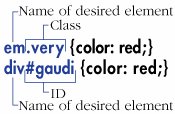Constructing Selectors
| The selector determines which elements a style rule is applied to. For example, if you want to format all p elements with the Times font, 12 pixels high, you'd need to create a selector that identifies just the p elements while leaving the other elements in your code alone. If you want to format the first p in each division with a special indent, you'll need to create a slightly more complicated selector that identifies only those p elements that are the first element in their division. A selector can define up to five different criteria for choosing the elements that should be formatted:
|
EAN: 2147483647
Pages: 340



